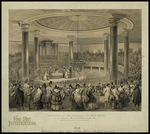American Art Union
Birth
In New York City, in 1842, a group of patriotic entrepreneurs, who wanted to promote American art and American artists, formed the American Art-Union (AAU). The businessmen recognized the potential of improved printing technologies. Not only could books and newspapers be printed more easily and quickly, through printed reproductions, art could be as well. For an annual membership fee of $10 (the equivalent of about $100 today), the American Art-Union guaranteed each member a reproduction of a painting purchased by Art-Union jurors. The fee also entered members in an annual lottery to win an original painting.

Library of Congress LC-DIG-pga-02613 (digital file from original print)
The AAU also maintained a free public art gallery in New York and published a magazine, The Union. Subscribers from all over the country could see the choices of the directors as the best of American art. As a result, prints of paintings by American artists hung in an ever-greater number of homes.
Growth
Through their purchases, the American Art-Union directors provided good artists not only income, but name recognition. To meet the approval of the jurors, the subject of the painting had to be “taken from every day scenes of life, those that are not suggestive of, or create painful emotions.”((A. Warner to Frederick E. Cohen, letter, New York, Aug. 12, 1848, coll. New York Historical Society, quoted in E. Maurice Bloch, George Caleb Bingham: The Evolution of an Artist,(Berkeley, California: University of California Press, 1967), 81.)) Selections ranged from landscapes created by artists associated with the Hudson River School such as Thomas Cole (1801-1848), Jasper Francis Cropsey (1823-1900), and John Kensett (1816-1872), to scenes from popular plays and novels, such as Washington Irving’s Legend of Sleepy Hollow by John Quidor (1801-1881). Artists Asher B. Durand (1796-1886) and John Blake White (1782-1859) painted famous moments from the Revolutionary War, Capture of Major Andre and General Marion Inviting a British Officer to Share His Meal. The jurors approved humorous pastoral scenes with subtle political commentary like Farmers Nooning by William Sidney Mount (1807-1868) and more overt political commentary like Old ’76 and Young ’48 by Richard Caton Woodville (1825-1855).
Some art critics of the time wondered how businessmen qualified as arbiters of taste. Critics also complained that by increasing the quantity of art, quality would suffer. But, over time, the democratization of art proved successful. Art critics now agree that the AAU’s directors selected well.((Joy Sperling, “Art, Cheap and Good:” The Art Union in England and the United States, 1840–60, Nineteenth Century Art Worldwide: A Journal of 19th Century Visual Culture, Vol. 1., No. 1, Spring 2002.))
Demise
In 1852, in response to a lawsuit by religious organizations, the New York State Supreme Court ruled the American Art-Union’s annual lottery illegal. But the Art-Union was already nearly dead from financial mismanagement. While in existence, the American Art-Union provided support to contemporary American artists. Their widely distributed choices gave Americans a visual identity of their country and themselves.

